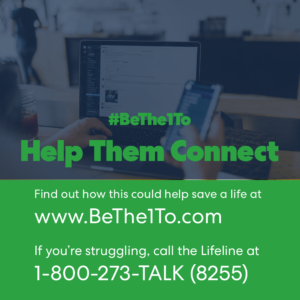In light of the coronavirus pandemic, many places have instituted distancing recommendations in order to control its spread. These recommendations encourage people to stay at home and avoid unnecessary excursions and crowds. In this environment, it is even more important to check in on your loved ones and support each other within these parameters. Physical distance does not have to mean social isolation – and social connection is more important than ever.
Infectious disease outbreaks such as COVID-19, as well as other public health events, can cause emotional distress and anxiety. These feelings of distress and anxiety can occur even if you are not at high risk of getting sick.
Many of the signs that someone may be considering suicide will be harder to read during times of physical distancing. Changes in routine especially will not be as apparent, but there are other things you can look for:
- Changes in tone, language, and time of day when texting, talking, or posting online
- Do they answer your calls or texts?
- Changes in the frequency (more or less) and content of what they might be sharing online or if they share media links with you
- In addition to the above, if there is a change in energy levels or appetite; increased use of drugs or alcohol; mood swings; trouble sleeping or relaxing; frequent headaches, stomachaches, or body pains; heightened worrying or anxiety; and inability to feel pleasure, it could be a reason to check in.
How to use the #BeThe1To steps during physical distancing
The #BeThe1To steps can be adjusted for staying connected during physical distancing. Below we have included some additions that allow you to tailor each step if you cannot be there physically with the person.
Ask

During times of physical distancing, you can use the same approach when asking someone if they are thinking about suicide. In addition to being generally alert for potential risk in all loved ones, it is useful to pay special attention to people that you know already struggle or have struggled in the past with emotional distress. Make sure to reach out more frequently to talk and check in and don’t wait for them to come to you to ask for help or connection. Helping people stay connected can help to prevent people from thinking about or acting on thoughts of suicide.
Be There
This step is very important in a world where we cannot be there physically – staying connected in other ways is needed. While being physically present may not be an option right now, there are still many other ways to be there for someone,  including speaking with them on the phone/video phone, by text, through various online platforms.
including speaking with them on the phone/video phone, by text, through various online platforms.
The important things to keep in mind when maintaining social connection through distance are the regularity and quality of the connection.
- Establish the frequency in which the person would like you to check in with them, and then stick to that schedule
- When talking on the phone or video calling with them, ensure that you are present. Remove yourself from distractions so that you can focus on your conversation with the person
Help Keep Them Safe
Use the same questions as you normally would to determine if the person has considered how they would kill themselves, and if they have access to means.

The same principles of putting time and space between the person and lethal means still apply here. You can use these questions/prompts to encourage the person to distance themselves from the means.
- If the person has access to their means, have an honest conversation with them about what they could do to make it harder for them to access those means in a crisis, when they might be more inclined to act impulsively.
- If the person has the means in hand while you are talking to them, ask if they could put it away from them while you talk. Call the Lifeline together.
- After you talk, ask the person to think about the overall safety of their environment. Is there anything else in their home, like firearms, that should be protected against to put more time and space between them and the potential means, even if those means weren’t the person’s first intended plan?
Help Them Connect
Helping people connect with other services that can support them is still possible while staying physically distant. Developing a safety plan is still an important step. 
The Lifeline (988) is another great option during times of distance – trained counselors are available to call, text or chat 24 hours a day, seven days a week, and 365 days a year.
Another option to allow people to feel connected by distance is the Vibrant Safe Space website. The Safe Space is home to resources and tools to provide you with some extra support in an emotionally safe environment.
A third option is to connect to a tele-mental health provider that can provide them with regular and consistent support from a mental health professional.
Follow Up
 Following up provides the person with a further feeling of connectedness. Similar to the principles of ‘be there’ during physical distancing, setting aside a time and date that you will follow up can provide something to look forward to and sends the message that you care. Be sure to clear your calendar of all distractions for the time. Never underestimate the value of showing up.
Following up provides the person with a further feeling of connectedness. Similar to the principles of ‘be there’ during physical distancing, setting aside a time and date that you will follow up can provide something to look forward to and sends the message that you care. Be sure to clear your calendar of all distractions for the time. Never underestimate the value of showing up.